Astrophytum Asterias (Star Cactus) Grow & Care Guide
Written by Iris
Sep 22 2021
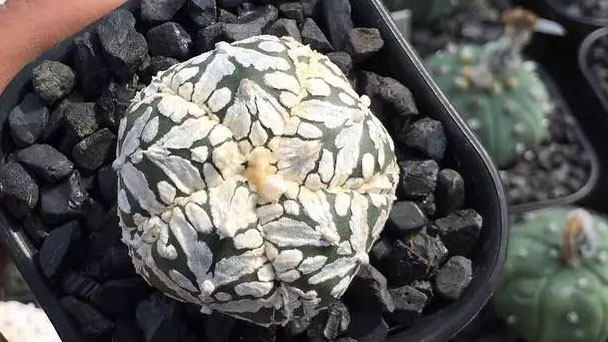
The Astrophytum Asterias (Star Cactus) is a slow-growing, thornless cactus known botanically as Astrophytum asterias. It also has other common names, such as Sand Dollar Cactus, Sea Urchin Cactus, and Star Peyote, related to the appearance of the Cactus. It is shaped like a dome and, although shallow, has five to eight green to brown-green ribs.
In the wild, growth of Star Cactus is fairly flat, almost flush with the ground, especially under dry conditions. This makes the plants very hidden, disappearing under the soil and leaves. Each triangular rib of the stem is lined with a white areola, which is covered with small white clusters.
This type of succulent prefers a warm climate. It can survive at zone 9a-11b which is around -6.7°C (20°F). If you live in a cold area, it is better to plant Super Kabuto in an indoor environment. As long as it gets enough sunlight, the plant will grow happily.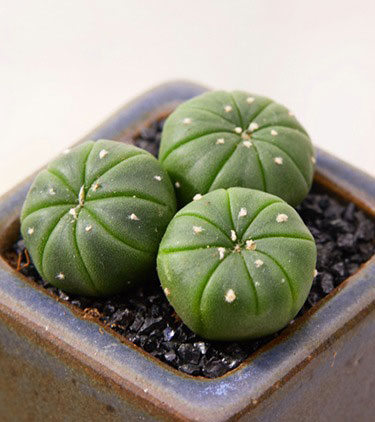
Their seeds are pretty fragile, so you should work with them very gently before planting. Also, you need to dig them in potting soil quickly after harvesting, as they have a short life on their own and fewer chances to root. Fill a tray or container with a fresh cactus mix, throw in the seeds, and cover them with little potting soil.
The growing medium of Astrophytum Asterias must be sealed with plastic wrap to retain humidity and heat. Once the seeds of Astrophytum Asterias have germinated, you can remove the plastic cover and move the pot to a sunny and warm location gradually. After a few weeks, the baby star cactus can be transplanted into their pots and provided with proper care.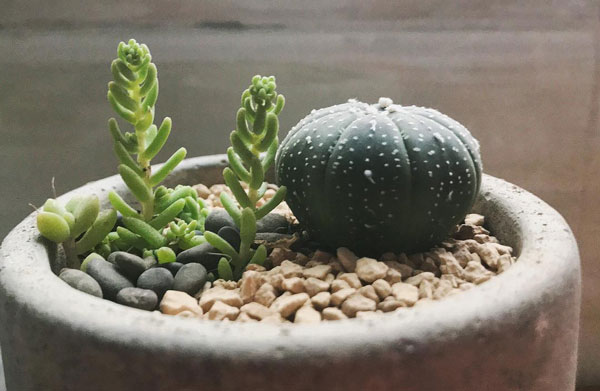
On the other hand, the star cactus does relatively well outdoors, as it loves bright and direct sunlight and it may therefore enjoy it. Astrophytum Asterias well appreciates an ample provision of natural sunlight, about 8 to 10 hours per day. Access to partial shade is also beneficial if the sun is too extreme.
Our cactus may be enduring too much sunlight if it starts becoming brown and yellow. Contrarily, if Astrophytum Asterias (Star Cactus) lacks sunlight, it’ll start lightening in color, from dark green to lighter shades of green. We must check for these signs and adjust appropriately, either by providing more partial shade or more direct light.
Use a peat-free soil or coconut coir mixed with minerals such as grit, sand, or perlite. Planting in the right type of soil will encourage healthy growth of Astrophytum Asterias (Star Cactus) and help to prevent root rot and disease.
Ready-mixed cactus and succulent soil is the easiest option and there are many to choose from with availability to either purchase online or at any good garden-supply retailer.
Alternatively, you can easily make your own good quality well-draining cactus soil at home. Start with one-third organic matter such as a good quality peat-free compost or coconut coir. Mix this with two-thirds of minerals such as grit, sand, or perlite.
A potted Star cactus will need about one watering every month. If you live in a region with hot climates, it may be necessary to water your cactus more frequently. Make sure their roots are not waterlogged, as this may result in root rot and irreversible damage. During the winter, you can water these cactus less often to avoid drowning them.
During the dormant months, the temperature really shouldn’t drop below 45ºF-55F (7ºC-12ºC). If necessary, simply move the cactus inside during this time where it’s going to be better protected from extremes.
Also, it is worth mentioning that Astrophytum Asterias (Star Cactus) can stand pretty extreme conditions regardless. Some of these plants can withstand temperatures as low as 20ºF (-6.7ºC). This, is not ideal. If the cactus is outside and frosty/winter conditions are expected, it’s best to bring it inside.
The astrophytum asterias is no different in this regard to other cactus: humidity is not ideal. Now then, it’s safe to say that this particular cactus is quite hardy. Average room humidity should not hurt it. Naturally, warmer and dry environments will serve it better.
Stem rot: Due to over-moistening, the star cactus become watery and swollen, this contributes to germination and spread of spores of pathogenic fungi, which can lead to the development of stem rot. If the affected area is small, it is often enough to allow it to dry out. However, the problem with stem rot is that the lesion is usually larger and stronger than it seems from the outside.
Root rot: This disease is usually found when it is too late. The roots die, the star cactus stem acquires a yellowish shade and becomes softer. Rot from the roots to the cambium penetrates to the core of the cactus. Root rot usually provokes too frequent watering. If this disease is found at an early stage, which is rare, you need to stop watering and leave the cactus for a long time without water, and then repot the plant into fresh soil with good drainage.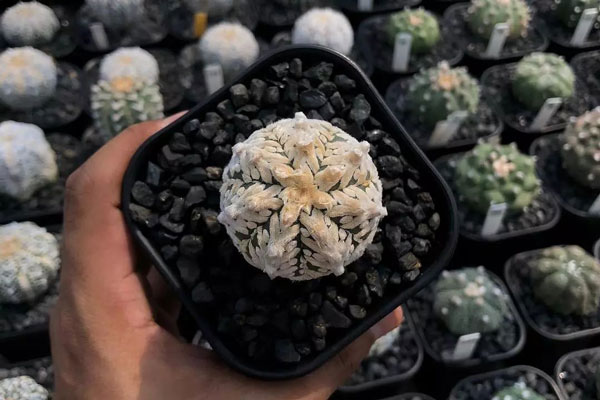
Astrophytum asterias ‘Ooibo Kabuto’
This cultivar stands out from the rest because of its large, wooly areoles. The wool can vary in color from pure white to a shade of yellow, orange, or brown.
Astrophytum asterias ‘Shinshowa Red’
This cultivar also goes by the names ‘Showa Red’, ‘Shinshowa Akabana’, and ‘Syowa Kabuto’. It’s one of the most popular cultivars because of its vibrant pinkish-red, orangish-red, or purple-red flowers.
Astrophytum asterias ‘Super Kabuto’
This cultivar may be the most popular Astrophytum asterias cultivar. It can be recognized by the mosaic of white spots across its epidermis. The flowers of this cultivar are yellowish-white with orange centers.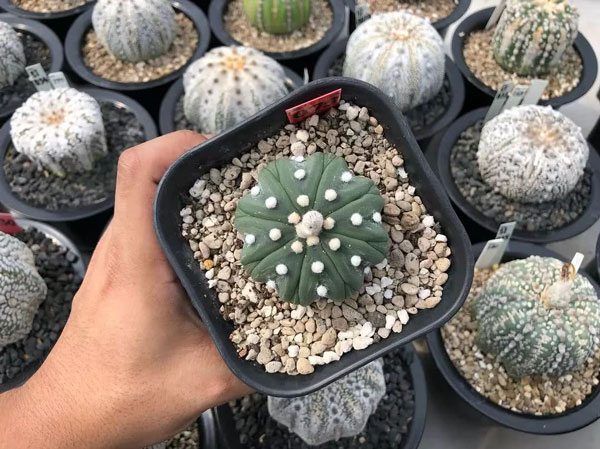
In the wild, growth of Star Cactus is fairly flat, almost flush with the ground, especially under dry conditions. This makes the plants very hidden, disappearing under the soil and leaves. Each triangular rib of the stem is lined with a white areola, which is covered with small white clusters.
Where to Grow Astrophytum AsteriasAstrophytum Asterias Propagation with SeedsHow to Care for Astrophytum Asterias (Star Cactus)Star Cactus Light CareStar Cactus Soil CareStar Cactus Water CareStar Cactus Temperature & Humidity CareStar Cactus Fertilizer CareStar Cactus Pests & Diseases CareVarieties of Astrophytum Asterias (Star Cactus)Astrophytum Asterias (Star Cactus) FAQIs Astrophytum Asterias (Star Cactus) edible?Is Astrophytum Asterias (Star Cactus) toxic?Are Astrophytum Asterias (Star Cactus) rare?
Where to Grow Astrophytum Asterias
Astrophytum Asterias (Star Cactus) succulents need strong light. When planting this succulent type in a garden, make sure it gets sunlight. Full to partial sun is the best for its growth. It is better to grow outdoor rather than indoor.This type of succulent prefers a warm climate. It can survive at zone 9a-11b which is around -6.7°C (20°F). If you live in a cold area, it is better to plant Super Kabuto in an indoor environment. As long as it gets enough sunlight, the plant will grow happily.

Astrophytum Asterias Propagation with Seeds
You can propagate Star cactus by seeds that can be found in their flowers. They can be removed from dried flowers and planted as regular store-bought seeds. This is by far the easiest method of astrophytum asterias propagation and can show nice results even to beginner gardeners.Their seeds are pretty fragile, so you should work with them very gently before planting. Also, you need to dig them in potting soil quickly after harvesting, as they have a short life on their own and fewer chances to root. Fill a tray or container with a fresh cactus mix, throw in the seeds, and cover them with little potting soil.
The growing medium of Astrophytum Asterias must be sealed with plastic wrap to retain humidity and heat. Once the seeds of Astrophytum Asterias have germinated, you can remove the plastic cover and move the pot to a sunny and warm location gradually. After a few weeks, the baby star cactus can be transplanted into their pots and provided with proper care.

How to Care for Astrophytum Asterias (Star Cactus)
Star Cactus Light Care
It's important to remember that if the Astrophytum Asterias (Star Cactus) is indoors, the plant will do well next to sunny windows. Astrophytum Asterias (Star Cactus) really enjoys sunlight and will achieve the best results with a steady provision of it. In other words, it’s important to provide the plant with at least a few direct sunlight hours. If this is not possible, some owners use LED lights to provide that extra amount of light needed.On the other hand, the star cactus does relatively well outdoors, as it loves bright and direct sunlight and it may therefore enjoy it. Astrophytum Asterias well appreciates an ample provision of natural sunlight, about 8 to 10 hours per day. Access to partial shade is also beneficial if the sun is too extreme.
Our cactus may be enduring too much sunlight if it starts becoming brown and yellow. Contrarily, if Astrophytum Asterias (Star Cactus) lacks sunlight, it’ll start lightening in color, from dark green to lighter shades of green. We must check for these signs and adjust appropriately, either by providing more partial shade or more direct light.
Star Cactus Soil Care
Like most other cactus, always use well-draining soil for growing Astrophytum Asteria. The roots need to be free from excess moisture to allow them to get the oxygen they need to thrive.Use a peat-free soil or coconut coir mixed with minerals such as grit, sand, or perlite. Planting in the right type of soil will encourage healthy growth of Astrophytum Asterias (Star Cactus) and help to prevent root rot and disease.
Ready-mixed cactus and succulent soil is the easiest option and there are many to choose from with availability to either purchase online or at any good garden-supply retailer.
Alternatively, you can easily make your own good quality well-draining cactus soil at home. Start with one-third organic matter such as a good quality peat-free compost or coconut coir. Mix this with two-thirds of minerals such as grit, sand, or perlite.
Star Cactus Water Care
We all picture Astrophytum Asterias (Star Cactus) as strong desert babies that can survive even the extreme hot-dry conditions. But Star cactus are a bit different! When it comes to watering, they love to be spoiled with lots of moisture once in a while. Of course, you will still need to allow the soil to dry out in-between waterings as with most cactus. These cactus only want a good soaking after their owner made them go through a long period of hard drought.A potted Star cactus will need about one watering every month. If you live in a region with hot climates, it may be necessary to water your cactus more frequently. Make sure their roots are not waterlogged, as this may result in root rot and irreversible damage. During the winter, you can water these cactus less often to avoid drowning them.
Star Cactus Temperature & Humidity Care
Ideally, we want to keep our Astrophytum Asterias (Star Cactus) in a particular range of conditions. Temperatures of around 70ºF (21ºC) or above are ideal for this cactus. This is no surprise since these plants thrive under warm conditions, much like other cactus.During the dormant months, the temperature really shouldn’t drop below 45ºF-55F (7ºC-12ºC). If necessary, simply move the cactus inside during this time where it’s going to be better protected from extremes.
Also, it is worth mentioning that Astrophytum Asterias (Star Cactus) can stand pretty extreme conditions regardless. Some of these plants can withstand temperatures as low as 20ºF (-6.7ºC). This, is not ideal. If the cactus is outside and frosty/winter conditions are expected, it’s best to bring it inside.
The astrophytum asterias is no different in this regard to other cactus: humidity is not ideal. Now then, it’s safe to say that this particular cactus is quite hardy. Average room humidity should not hurt it. Naturally, warmer and dry environments will serve it better.
Star Cactus Fertilizer Care
Fertilize Astrophytum Asterias (Star Cactus) during the growing season with a balanced, fertilizer, such as 20-20-20, mixed into the water.Star Cactus Pests & Diseases Care
Powdery mealworms: These insects often attack the star cactus. These pests are suckers, they suck the juices from the plant, and also are carriers of various diseases, moving from a sick Astrophytum Asterias (Star Cactus) to a healthy one, they also infect it. To fight, you need to use insecticidal soap, following the directions on the label.Stem rot: Due to over-moistening, the star cactus become watery and swollen, this contributes to germination and spread of spores of pathogenic fungi, which can lead to the development of stem rot. If the affected area is small, it is often enough to allow it to dry out. However, the problem with stem rot is that the lesion is usually larger and stronger than it seems from the outside.
Root rot: This disease is usually found when it is too late. The roots die, the star cactus stem acquires a yellowish shade and becomes softer. Rot from the roots to the cambium penetrates to the core of the cactus. Root rot usually provokes too frequent watering. If this disease is found at an early stage, which is rare, you need to stop watering and leave the cactus for a long time without water, and then repot the plant into fresh soil with good drainage.

Varieties of Astrophytum Asterias (Star Cactus)
There are a few different cultivars that have mainly been produced by Japanese gardeners. They all require similar care but are slightly different in appearance. All cultivars produce large, showy flowers when in bloom.Astrophytum asterias ‘Ooibo Kabuto’
This cultivar stands out from the rest because of its large, wooly areoles. The wool can vary in color from pure white to a shade of yellow, orange, or brown.
Astrophytum asterias ‘Shinshowa Red’
This cultivar also goes by the names ‘Showa Red’, ‘Shinshowa Akabana’, and ‘Syowa Kabuto’. It’s one of the most popular cultivars because of its vibrant pinkish-red, orangish-red, or purple-red flowers.
Astrophytum asterias ‘Super Kabuto’
This cultivar may be the most popular Astrophytum asterias cultivar. It can be recognized by the mosaic of white spots across its epidermis. The flowers of this cultivar are yellowish-white with orange centers.

Astrophytum Asterias (Star Cactus) FAQ
Is Astrophytum Asterias (Star Cactus) edible?
Occasionally, the plant will produce pink flowers which become club-shaped, edible pink berries. The plant is considered endangered due to over harvesting and land development. A similar looking cactus, Astrophytum asterias, or star cactus, is legal to grow, but it is also endangered.Is Astrophytum Asterias (Star Cactus) toxic?
Astrophytum Asterias (Star Cactus) has no toxic effects reported.Are Astrophytum Asterias (Star Cactus) rare?
Astrophytum asterias, commonly called star cactus, is a federally listed endangered cactus endemic to the Tamaulipan thornscrub ecoregion of extreme southern Texas, USA, and Tamaulipas and Nuevo Leon, Mexico. Only three metapopulations totaling less than 4000 plants are presently known in Texas.Latest Updated
- Benefits of Bugleweed - 7 Science-backed Health Benefits
- Bugleweed Dangers & Side Effects - Is It Poisonous?
- How to Plant Evergreen Trees - What You Should Know
- When to Plant Evergreens - Grow Guide for Evergreen Trees
- 12 Wonderful Evergreen Shrubs for Your Garden
- 12 Popular Evergreen Plants with Pictures for Beginners
- When And How To Prune A Lilac Bush Like a Pro
- How to Grow & Care for Lilac Vine (Hardenbergia Violacea)
- Japanese Lilac Tree (Syringa Reticulata) Care & Propagation Guide
- Shumard Oak Pros and Cons - What to Know
Popular Articles
- Winter maintenance of Antirrhinum Majus
- How to Grow Terminalia Mantaly Tree
- How to Grow and Care for Crossostephium Chinense
- How to grow Antirrhinum Majus in spring
- Peristeria Elata (Dove Orchid) Profile: Info & Care Guide
- Underwatered Snake Plant (Sansevieria Trifasciata) - Signs And How To Fix
- How to Care for Brazilian Jasmine Plant (Mandevilla Sanderi)
- How to Grow & Care for Graptopetalum Purple Delight in Summer
- Rosa Chinensis (China Rose): Plant Growing & Care Tips
- How to Care for Baby Sun Rose (Aptenia Cordifolia)